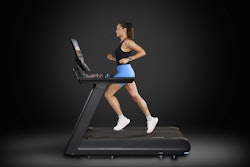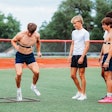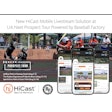SOURCE: National Athletic Trainers’ Association
DALLAS, December 19, 2014 – With the holidays here, shorter days of sunlight and cold weather conditions across the country, it’s important to exercise or maintain physical activity with safety and good results in mind. The National Athletic Trainers’ Association (NATA) has reissued guidelines that people of all ages can follow to reduce the risk of injuries and illnesses that may occur from cold weather activity.
“Many cases of cold-related injuries are preventable and can be successfully treated if they are properly recognized and treated efficiently and effectively,” said Thomas A. Cappaert, PhD, ATC, CSCS, professor at Rocky Mountain University of Health Professions in Provo, Utah, and the lead author of NATA’s position statement on environmental cold injuries. The recommendations were originally published in the Journal of Athletic Training, NATA’s scientific publication.
Exposure to cold environments — and thus increased risk for cold injury — is a common occurrence for many types of athletes and for those in different occupations, says Cappaert. These include traditional winter sport athletes; endurance athletes; athletes in traditional team sports with seasons that last into early winter or begin in early spring; as well as military personnel, public safety or public service personnel and construction/maintenance workers.
Preventive Guidelines
To guard against illness and injury caused by outdoor activity in cold weather, NATA recommends implementing a risk management process that includes strategies for preventing, recognizing and treating cold injuries. In addition, when getting ready to exercise in cold weather, one should follow the following preventive guidelines:
•Wear insulating clothing in layers that allows adjustment to changing weather conditions and also allows evaporation and minimal absorption of perspiration;
•Re-warm your body as needed during outdoor activities. Use external heaters, wear additional clothing or layer clothing or take regular breaks in a warm indoor environment;
•Make sure to eat a well-balanced diet and stay hydrated with water or sports drinks. Avoid alcohol.
Cold-weather injuries are classified into three categories: decreased core temperature (e.g., hypothermia), freezing injuries of the extremities (e.g., frostbite) and nonfreezing injuries of the extremities (e.g., chilblains and trench foot). Prevention and treatment recommendations include:
1. Hypothermia: The signs and symptoms of mild hypothermia include vigorous shivering, increased blood pressure, core body temperature less than 98.6F(37.6C) but greater than 95.6F (35.6C), fine motor skill impairment, lethargy, apathy and mild amnesia. What to do: Remove wet or damp clothing; insulate the subject with warm, dry clothing or blankets and move him or her to a warm environment with shelter from the wind and rain. Apply heat only to the trunk and other areas that will absorb heat quickly including the armpit, chest wall and groin. Provide warm, nonalcoholic fluids and food to help sustain shivering and maintain metabolic heat production. Avoid applying friction massage to tissues, which may increase damage if frostbite is present.
2. Frostbite: Be aware of signs and symptoms of superficial frostbite, which include swelling, redness or mottled gray skin appearance, stiffness and transient tingling or burning. What to do: Re-warm the affected tissue initially by wrapping the area in warm clothing. If sensation or normal color does not return after a few minutes, extremities should be immersed in a warm (98.6F–104.6F [36.6C–40.6C]) water bath for 15 to 30 minutes. Thawing is complete when the tissue is pliable and color and sensation have returned. Avoid friction massage to the area or exposing the areas to direct heat such as a heating pad or fire.
3. Chillblain: Occurs with exposure to cold, wet conditions for more than 60 minutes at temperatures less than 50.6F (16.6C). It can be identified by the presence of small red bumps, swelling, tenderness, itching and pain. What to do: Remove wet or constrictive clothing, wash and dry the area gently, elevate the area, and cover with warm, loose, dry clothing or blankets. Do not disturb blisters and refrain from applying friction massage, creams or lotions or high levels of heat. Do not allow any weight bearing on the affected area.
4. Immersion (Trench) Foot: Occurs with exposure to cold, wet environments for 12 hours to three or four days. Symptoms include burning, tingling or itching, loss of sensation, bluish or blotchy skin, swelling, pain or sensitivity, blisters and skin fissures or maceration. What to do: Thoroughly clean and dry the feet, then treat the affected area by applying warm packs or soaking in warm water for approximately five minutes. Replace wet socks with a clean, dry pair and rotate footwear or allow footwear to dry before reusing.
Children should take similar preventive measures as those suggested for adults, but they should also be encouraged to take more frequent breaks from a cold environment. Similarly, as adults reach the age of 50, the ability to tolerate cold decreases and risk of hypothermia increases.
“With advance planning and education, we can all enjoy cold weather activities as long as we adhere to protocols that ensure safety and good health first,” added Cappaert.
To read “National Athletic Trainers’ Association Position Statement: Environmental Cold Injuries,” visit https://www.nata.org/sites/default/files/EnvironmentalColdInjuries.pdf
About National Athletic Trainers’ Association (NATA)
Athletic trainers are health care professionals who specialize in the prevention, diagnosis, treatment and rehabilitation of injuries and sport-related illnesses. They prevent and treat chronic musculoskeletal injuries from sports, physical and occupational activity, and provide immediate care for acute injuries. Athletic trainers offer a continuum of care that is unparalleled in health care. The National Athletic Trainers' Association represents and supports 39,000 members of the athletic training profession. Visit www.nata.org































